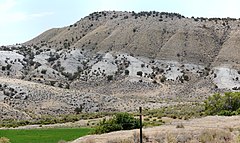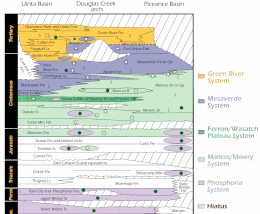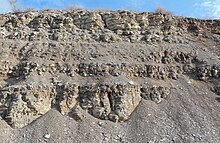| Mowry Shale | |
|---|---|
| Stratigraphic range: Albian PreꞒ Ꞓ O S D C P T J K Pg N | |
 Characteristic white or silvery colored Mowry Shale below the Mancos Shale, west of Dinosaur National Monument. Characteristic white or silvery colored Mowry Shale below the Mancos Shale, west of Dinosaur National Monument. | |
| Type | Geological formation |
| Location | |
| Region | Johnson County, Wyoming |
| Type section | |
| Named by | N. H. Darton in 1904 |


The Mowry Shale is an Early Cretaceous geologic formation. The formation was named for Mowrie Creek, northwest of Buffalo in Johnson County, Wyoming.
Description

The Mowry Shale or Fish-scale Beds because of the abundance of fish scales, is a dark-gray, siliceous shale that weathers silver gray; it is 10-70 m thick. 40Ar/39Ar of sanidine from a bentonite yielded an age of 97.17 +/-0.69 Ma, thus is Cenomanian in age. Fossils indicate the Mowry was deposited during the early stages of the Western Interior Seaway.
Age
In so much as the Mowry was observed to lie above formations that were originally thought to be associated with the difficult to date upper Dakota units, especially Newcastle Sandstone, the Mowry was previously thought to be of Cenomanian age. However, recent studies, particularly of fossil pollens and spores, have dated the Mowry to the late-Albian. In many locations, the Mowry is bounded above by the Clay Spur bentonite, which is assigned the radiometric date of 97 million years, the upper Mowry may extend into the earliest Cenomanian.
Paleontology
Invertebrate fossils known include the ammonites Metengonoceras aspenanum, Metengonoceras teigenense, Neogastroplites americanus, and Neogastroplites muelleri.
Isolated, lenticular accumulations of fish bones, scales, teeth and coprolites are thought to represent storm lag deposits formed by winnowing of the seafloor and concentration of the bones in bottom scours. The following fish species have been identified from the Mowry: an unnamed caturid, an unnamed ichthyodectid, Clupavus sp., Enchodus sp., Apateodus sp., an unnamed alepisaurid, and Xenyllion zonensis. Xenyllion is the oldest acanthomorph (spiny-rayed) teleost in North America.
Dinosaur remains diagnostic to the genus have been recovered from the formation.
Distribution
The Mowry outcrops or occurs at depth in parts of Colorado, Montana, North Dakota, South Dakota, Utah and Wyoming. It occurs within the following geologic regions:
- Big Horn Basin
- Central Montana Uplift
- Chadron Arch
- Denver Basin
- Green River Basin
- Montana Fold Belt
- North Park Basin
- Powder River Basin
- Sweetgrass Arch
- Uinta Uplift
- Williston Basin
- Wind River Basin
- Yellowstone Province
See also
References
- ^ Greg A. Ludvigson, Brian J. Witzke (2010). "New Insights on the Sequence Stratigraphic Architecture of the Dakota Formation in Kansas–Nebraska–Iowa from a Decade of Sponsored Research Activity" (PDF). Current Research in Earth Sciences (258): Palynostratigraphy and Correlation of the Dakota Formation in the Type Area, Iowa, Nebraska, and Kansas. Retrieved September 10, 2021.
Although the Mowry had been considered to be a lower Cenomanian unit in some previous reports, recent biostratigraphic and chronostratigraphic studies now support an uppermost Albian age.
- ^ "Geologic Unit: Mowry". National Geologic Database. Geolex — Significant Publications. United States Geological Survey. Retrieved 2020-11-27.
- Obradovich, J.D., 1993, A Cretaceous time scale, IN Caldwell, W.G., and Kauffman, E.G., eds., Evolution of the Western Interior basin: Geological Association of Canada Special Paper, 39, p. 379-396.
- "Geologic Unit: Newcastle". National Geologic Database. Geolex — Significant Publications. United States Geological Survey. Retrieved 2021-09-11.
- Kennedy, W.J., 1989. The Ammonite Metengonoceras Hyatt, 1903, from the Mowry Shale (Cretaceous) of Montana and Wyoming. U.S. Geological Survey Bulletin 1787-L, p. 1-11.
- Anderson, A.D., and Kowallis, B.J., 2005, Storm deposited fish debris in the Cretaceous Mowry Shale near Vernal, Utah. In Dehler, C.M., Pederson, J.L., Sprinkel, D.A., and Kowallis, B.J., editors, Uinta Mountain geology: Utah Geological Association Publication 33, p. 125-130.
- Stewart, J.D. and Hakel, M., 2006. Ichthyofauna of the Mowry Shale (Early Cenomanian) of Wyoming. In, Lucas, S.G., and Sullivan, R.M. (editors), Late Cretaceous Vertebrates from the Western Interior. New Mexico Museum of Natural History and Science Bulletin 35, p.161-163.
- Weishampel, et al. (2004). "Dinosaur distribution." Pp. 517-607.
- Mowry Shale
- Weishampel, David B.; Dodson, Peter; and Osmólska, Halszka (eds.): The Dinosauria, 2nd, Berkeley: University of California Press. 861 pp. ISBN 0-520-24209-2.
This article about a specific stratigraphic formation in the United States is a stub. You can help Misplaced Pages by expanding it. |